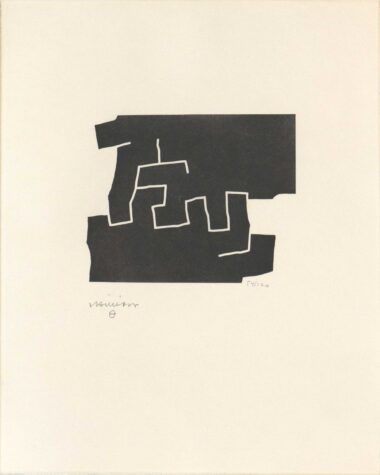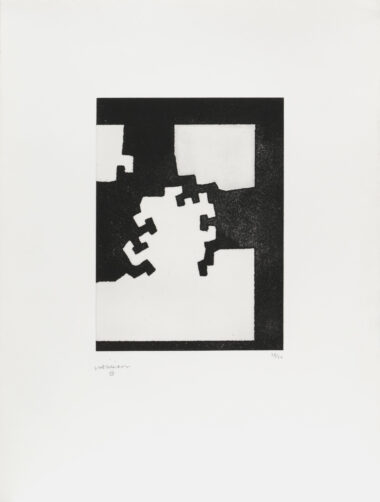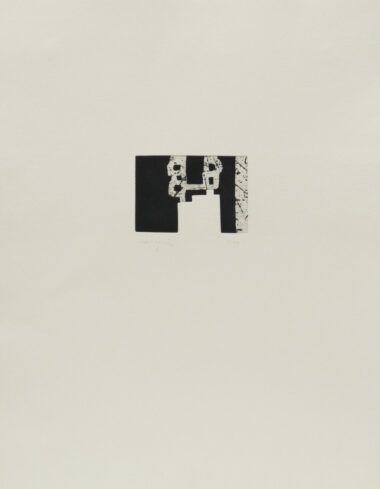

Eduardo CHILLIDA was born on January 10, 1924 in San Sebastián, in the Basque Country of Spain. After dropping out of architectural studies at the Colegio Mayor de Cisneros (1943 to 1946), he attended the private art academy Circulo de Bellas Artes in Madrid. From 1949 Chillida lived and worked in Paris. He produced figurative sculptures and took part in the Salon de Mai. The sculptor returned to Spain in 1950 and settled in Villa Paz in San Sebastián in 1957. In 1971 Chillida followed a visiting professorship at the Carpenter Center for the Visual Arts, Haward University, Cambridge, Massachusetts. From 1954, Chillida took part in exhibitions and participations in exhibitions at home and abroad, including the documenta in Kassel (1959 to 1977) and the Venice Biennale (1958 and 1990). Since his first abstract iron sculptures, the artist was concerned with the “sense of space”. Using a variety of materials, wood, steel, alabaster, granite, clay, and the prints he created, especially in the 1960s and 1970s, he traced the boundaries of space. Characteristic of his plastic works of art is the homogeneous materiality and the subdivision into figure forms. In 1984, his family established the Chillida Foundation. In 2000, the Museo Chillida-Leku was opened in Hernani. The artist’s works are represented in public and private collections and museums, including the Museo Nacional Centro de Arte Reina Sofia, Madrid, Nationalgalerie, Berlin, Sprengel Museum, Hanover, Städtisches Museum Abteiberg, Mönchengladbach, Galleria Nazionale d’Arte Moderna, Rome, Tate Britain, London, Kunstmuseum Basel, Metropolitain Museum, New York, Carnegie Institute, Pittsburgh, Maeda Environmental Art, Tokyo. Chillida is one of the most famous sculptors and graphic artists of the 20th century. Eduardo Chillida died on August 19, 2002 in San Sebastián.
Eduardo CHILLIDA was born on January 10, 1924 in San Sebastián, in the Basque Country of Spain. After dropping out of architectural studies at the Colegio Mayor de Cisneros (1943 to 1946), he attended the private art academy Circulo de Bellas Artes in Madrid. From 1949 Chillida lived and worked in Paris. He produced figurative sculptures and took part in the Salon de Mai. The sculptor returned to Spain in 1950 and settled in Villa Paz in San Sebastián in 1957. In 1971 Chillida followed a visiting professorship at the Carpenter Center for the Visual Arts, Haward University, Cambridge, Massachusetts. From 1954, Chillida took part in exhibitions and participations in exhibitions at home and abroad, including the documenta in Kassel (1959 to 1977) and the Venice Biennale (1958 and 1990). Since his first abstract iron sculptures, the artist was concerned with the “sense of space”. Using a variety of materials, wood, steel, alabaster, granite, clay, and the prints he created, especially in the 1960s and 1970s, he traced the boundaries of space. Characteristic of his plastic works of art is the homogeneous materiality and the subdivision into figure forms. In 1984, his family established the Chillida Foundation. In 2000, the Museo Chillida-Leku was opened in Hernani. The artist’s works are represented in public and private collections and museums, including the Museo Nacional Centro de Arte Reina Sofia, Madrid, Nationalgalerie, Berlin, Sprengel Museum, Hanover, Städtisches Museum Abteiberg, Mönchengladbach, Galleria Nazionale d’Arte Moderna, Rome, Tate Britain, London, Kunstmuseum Basel, Metropolitain Museum, New York, Carnegie Institute, Pittsburgh, Maeda Environmental Art, Tokyo. Chillida is one of the most famous sculptors and graphic artists of the 20th century. Eduardo Chillida died on August 19, 2002 in San Sebastián.




Recent Comments